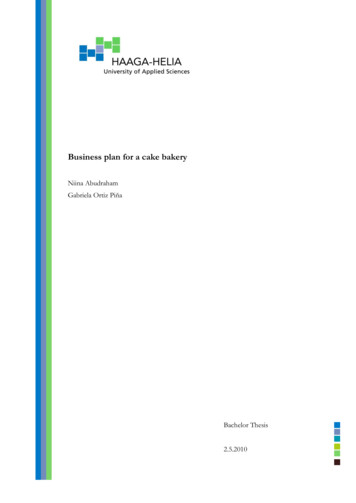
Transcription
Business plan for a cake bakeryNiina AbudrahamGabriela Ortiz PiñaBachelor Thesis2.5.2010
Abstract2.5.2010Degree Programme in International BusinessAuthorsNiina Abudraham, Gabriela Ortiz.GroupLIIBBA04STitle of your thesisBusiness plan for a cake bakeryNumber of pagesand appendices29 36SupervisorsPäivi Käri-Zein, Suvi KalelaThe objective of this Bachelor’s thesis was to produce a feasible business plan for a cake bakery in Helsinki. The end users of project outcome, the business plan, are one of the authorswith another HAAGA-HELIA graduate. The plan is also a tool for the end users for assessingthe personal readiness for becoming an entrepreneur as well as for assessing the business ideaand the operational plan. Second, the plan is needed to prove that the business idea is viableand to obtain financial resources. The aim is to utilize the plan and to start the business by theend of year 2010.The theoretical framework of this thesis is about entrepreneurship, business planning in perspective of starting a new business, and project management. The focus is in business planand its content. The theory for project management supported the planning and implementation of the project.The project implementation began with the business plan development, which started with theinformation gained in the Entrepreneurship information session given by EnterpriseHelsinki.Business plan was written according to the EnterpriseHelsinki business and the research wasdone by using secondary data. The project was successfully completed on March 29th.The business plan suggested that there is a realistic opportunity for a profitable cake bakerybusiness in Töölö, Helsinki. Finally, the business plan was reviewed and analysed by an Enterprise Helsinki business advisor. The advisor evaluated the coherence of the business idea, itsprofitability and realism. After the evaluation the advisor gave his recommendation on furtheraction. According to the business advisor evaluation, the business plan contains sufficient information for applying for a loan from Finnvera.KultaKakku's vision for the next five years after the start-up is to become a supplier of cakesand bakery goods for local restaurants, coffee houses, grocers and catering. The founders ofKultaKakku also see the possibilities to open other cake shops in different areas of Helsinki.Key wordsCake bakery, business plan, project management
Table of contents1 Introduction . 12 Theoretical framework . 32.1 What is an entrepreneur? . 32.2 Entrepreneurial process . 42.3 What is a business plan. 52.3.1 Content of a business plan . 72.4 Project management . 102.5 Project Management functions . 112.5.1 The General Project Management process . 112.5.2 Basic project management functions . 122.5.3 The integrative project management functions . 122.5.4 Project life-cycle . 133 Project plan . 153.1 Background and the scope of the project. 153.2 Project organization . 153.3 Risk analysis . 173.4 Acquisitions and other costs. 173.5 Work plan . 183.5.1 Phasing and tasks. 183.5.2 Work methods . 184 Project implementation . 204.1 Research process for the business plan. 204.2 Results . 224.3 Reliability and Validity . 235 Conclusion . 255.1 Conclusion and recommendations . 255.2 Future studies. 26Bibliography . 28Appendices . 30Appendix 1. Project risk analysis . 30Appendix 2. Project schedule and tasks . 31
Appendix 3. Business plan for KultaKakku . 32
1IntroductionThe purpose of this product-oriented thesis is to create a business plan for a cake bakery. Thetopic was chosen because both of the authors have a common interest in entrepreneurship.Becoming an entrepreneur and opening a cake bakery in the near future is an option for oneof the authors.The need for providing a business plan at this moment is justified for a reason that the authoris approaching to a turning point in her life in which choices for future should be done. Before one is able to make decisions, evaluations and planning is advisable to be done beforehand. One should list the main options for employment. Once the options are clear, oneshould evaluate the goals to be achieved and the realistic probabilities for achieving thosegoals. One option for the author is to put her business idea in action and to employ herself.The second author is an active actor in a recently opened family business in food industry.Since she has gained valuable experience on the business planning and financing applicationprocess as well as on the services offered by Uusyrityskeskus and EnterpriseHelsinki, the authors are able to combine their knowledge, ideas and professional experience in order to create an inclusive, feasible business plan. In order to accomplish the goals of this projectoriented thesis, the following guiding question was formulated:-How to create a feasible business plan for a start-up bakery business?The study uses a range of primary and secondary sources. According to Hatte (1997, 246) secondary sources of data are those which already exist, having been gathered for some otherpurpose. Hatten (1997, 246) suggests that should checked first because they are less time consuming and cheaper than conducting your own study. The research problem could be solvedwithout an extended primary research (Hatten 1997, 246). Primary data is defined as data collected specifically for the research project being undertaken (Saunders, Lewis & Thornhill,2009, 598).For this study secondary sources include annual industry reports, books, government webbased sources and competitors' web pages. As primary data sources, qualitative methods ofobservation and an interview have been used. Observation was used in order to define thestrengths and weaknesses of the company's competitors. Observation was accomplished byvisiting the competitors' bakeries and coffee shops in Töölö, Helsinki. The business plan waspresented to a business advisor from EnterpriseHelsinki, who evaluated the business plan.1
The 2,5 hours meeting gave an opportunity for an unstructured interview and observationwith an expert in establishing business.The benefits gained from this study are the understanding of the process of establishing abusiness and a completed business plan for a cake bakery business which is needed to establish a cake bakery in Helsinki in the near future.The thesis was conducted as a project. Different stages of project work and project management are clarified within the theoretical framework. The project assignment is to write a business plan, including a marketing, operational and financial plan, for a cake bakery.The theoretical part focuses on the business plan and its contents, explaining each part of thebusiness plan. As a result, the authors apply the knowledge gained through the informationgiven in the theoretical part in order to create a feasible business plan, which is needed toprove that the business idea is viable and to obtain financial resources.2
2 Theoretical frameworkThe theoretical framework of this thesis is built from the main concepts of entrepreneurship,business planning and project management. Clarifications and precisions of these concepts areachieved through relevant definitions. For creating a business plan for a cake bakery, a theoryis build from these definitions.First, the definition of entrepreneurship is discussed and continued with the entrepreneurialprocess. The second part of the theoretical framework explains the definition of the businessplan and its content. The theory of business plan is followed by project management.2.1What is an entrepreneur?The word entrepreneur is derived from the French entrependre, meaning to “undertake.” Theentrepreneur is one who undertakes to organize, manage, and assume the risks of a business.Today, an entrepreneur is an innovator of developer who recognizes and sizes opportunitiesinto workable/ marketable ideas; adds value through time, effort, money, or skills; assumesthe risks of the competitive marketplace to implement these ideas; and realizes the rewardsfrom these efforts. (Kuratko & Hodgets 2001, 28.)The term has evolved over the years into a multitude of definitions but most include the following behaviours:-Creation: A new business is started.-Innovation: The business involves a new product, process, market, material, or organization.-Risk assumption: The owner of the business bears the risk of potential loss or failureof the business.-General management: The owner of the business guides the business and allocates thebusiness's resources.-Performance intention: High levels of growth and/or profit are expected. (Hatten1997, 31.)3
All new businesses require a certain amount of entrepreneurial skill. The degree of entrepreneurship involved depends on the amount of each of these behaviours that is needed. (Hatten1997, 31.)Normally defined as risk takers in new-venture creations, entrepreneurs are uniquely optimistic, hard-driving, committed individuals who derive great satisfaction from being independent.Starting a new business requires more than just an idea; it requires a special person, an entrepreneur, who uses sound judgment and planning along with risk taking to ensure the successof his or her own business. (Kuratko & Hodgets 2001, 95.)According to Legge and Hindle (2004, 35) entrepreneurs earn their reward by managing projects and accepting and managing associated uncertainty. This does not make an entrepreneura gambler, but far from it. Legge and Hindle (2004, 35) state that the best entrepreneurs arenot risk takers, although, part to their tasks is to manage risks. Entrepreneurs choose to 'enterand take charge' of the projects where they have some special advantage, which means thatthe dangers the uncertain world presents to the project are less, as long as the entrepreneur ismanaging it, than they would be if the government, or the financier or customer, attempted tomanage the project directly. (Legge & Hindle 2004, 35.)2.2Entrepreneurial processAccording to Hatten (1997, 32), the entrepreneurial process begins with an innovative idea fora new product, process, or service, which is refined as you think it through. The time span forinnovation stage may be moths or even years before the potential entrepreneur moves to thenext stage. Usually a specific event or occurrence sparks the entrepreneur to proceed fromthinking to doing a triggering event. (Hatten 1997, 32.)When triggering event occurs in the entrepreneur's life, he or she begins bringing the organization to life. The event could be the loss of a job, the successful gathering of resources to support the organization, or some other factor that sets the wheels in motion. Implementation isthe part of the entrepreneurial process when the organization is formed. Risk increases at thisstage of the entrepreneurial process because a business is now formed. The innovation goesfrom being an idea in your head to committing resources to bring it to reality. (Hatten 1997,32.)4
Different stages of an entrepreneurial process require different skills and emphases. One ofthe most cited and author modified stage models of the entrepreneurial process were introduced by Moore in 1986. (Legge & Hindle 2004, 383.) The next figure (Figure 1) presents amodified depiction of Moore's stage model of the entrepreneurial process.PERSONALPERSONALInternal controlAmbiguitytolerancePersonal valuesRisk takingEducationExperienceRisk takingJobDissatisfactionJob ICALPERSONALNetworksTeamsParentsFamilyRole MENTENVIRONMENTOpportunitiesRole LawyersResourcesGovernmentpolicyFigure 1. Moore's framework of the influences on entrepreneurial process through time(Legge & Hindle 2004, 383)2.3What is a business planA business plan is a written document that demonstrates persuasively that enough products orservices can be sold at a profit to become a viable business. A business plan gives the reader5
the what, where, why, and how your business will accomplish its objectives and tells who willbe involved in running it. (Hatten 1997, 94.)Corman and Lussier (1996, 112-113) describe the business plan as the single most importantelement in either starting or running a business. A business plan will help to predict the firm'sprofit (or losses). A business plan is also a key element for all types of small businesses,whether is a start-up venture a plan may be likened to developing a blueprint for a new building, since is the first activity to be undertaken before work on the structure itself begins.(Corman & Lussier 1996, 112-113.)According to Longenecker, Moore and Petty (1997, 115) the business plan is the entrepreneur's blueprint for creating the new venture; in this sense it might be called the first creation.Without first mentally visualizing the desired end result, the entrepreneur probably will notbecome a physical reality or the second creation. For anything is built, a house or a business,there is always a need for a written plan. This blueprint is in essence, a bridge between themental and the physical, between the idea and reality. The business plan role is to provide aclear visualization of what the entrepreneur intends to do. (Longenecker et al. 1997, 115.)The primary purpose of the business plan is to thoroughly analyze the business as a whole andto make considerations concerning the potential problem areas. A plan provides the owner ormanager with an analysis of each aspect of the business; it reveals previously concealed problems as well as potential profit areas. A business plan also provides projections of costs, market share, production, and profits. It will assist the business owner in securing investmentcapital. (Corman & Lussier 1996, 113.)For an entrepreneur starting a new venture, a business plan is a written document that accomplishes two basic objectives. First, it identifies the nature and the context of the business opportunity -why does such an opportunity exist? Second, the business plan presents the approach the entrepreneur plans to take to exploit the opportunity. (Longenecker et al 1997,115.)The entrepreneur generally perceives a new venture very differently than the investor does.The entrepreneur will characteristically focus on the positive potential of the start-up – whatwill happen if everything goes right. The prospective investor in the other hand plays the roleof the sceptic, thinking more about what could go wrong. Entrepreneur's failure is not only to6
understand but also to appreciate this difference in perspectives greatly increases the chance ofrejection by an investor. (Longenecker et al. 1997, 118.)The business plan is fundamental because it is a road map. It shows the ultimate destinationand how to get there. It even allows for unexpected detours and unforeseen problems. Itshows how to change the route and still drive ahead safely. Use of a plan is necessary for newor established ventures. (Corman & Lussier 1996, 125.)2.3.1Content of a business planThe business plan for each new venture is unique, and that uniqueness must be recognized.However, a prospective entrepreneur needs a guide to follow in preparing a business plan.While no single standard format is in general use, there is considerable similarity in basic content among many business plans. (Longenecker et al. 1997, 123.)In the following figure (Figure 2) three examples of a business plan contents is introduced.The format of Uusyrityskeskus is used for KultaKakku business plan.7
Corman & Lussier 1996Longenecker et el 1997IntroductionStrategy formationThe accounting functionThe marketing functionLocation and layoutThe production/ operations functionThe personnel functionThe financing functionControlsThe executive summaryCover pageExecutive summaryGeneral company descriptionProducts and /or services planMarketing planManagement planOperating planFinancial planAppendixUusyrityskeskus 2010Business idea summarySkillsProducts and servicesCustomers and marketMarkets and competitorsCompany: Corporate form, shareholders, employees, premises, etc.Accounting and financial planningFinancial, profitability and sales calculationsFigure 2. Three examples of business plan contents (Corman & Lussier 1996. Longenecker etel 1997. Uusyrityskeskus 2010)A business plan consist of the major sections of cover page, executive summary, general company description, the target market description and products, marketing, operating and financial plans.The cover page or title page is the firs page of the business plan and should contain informationsuch as the name of the business, the time period of the plan, the names of the founding directors, the names of the people to whom the plan is being presented, and the date of thepresentation. (Longenecker et al. 1997, 123.)The executive summary is crucial for getting the attention of the one-minute investor. It must,therefore, convey a clear and concise picture of the proposed venture and, at the same time,create a sense of excitement regarding its prospects. Even though the executive summary8
comes at the beginning of the business plan, it provides an overview of the whole plan andshould be written last. (Longenecker et al. 1997, 123.)The main body of the business plan begins with a brief description of the company. This sectioninforms the reader as to the type of business being proposed, the firm's objectives, where thefirm is located, and whether it is serving a local or international market. In many cases, legalissues – especially the form of organization – are addressed in this section of the plan. (Longenecker et al 1997, 124.) Stevenson, Robert, Grousbeck and Bhidé (1999, 45) continue thatthis section should also describe how the company will be organized, who will fill these roles,and what their responsibilities will be. Some background on the founders should be given andtheir more extensive résumés referenced in an appendix. The story of how the company cameinto being should be briefly told so that potential investors get some sense of its history. Thesection should describe the current status of the company: number of employees, sales andprofits, products, facilities, and so forth. Finally, this section should paint a picture of wherethe company hopes to go and how it envisions getting there - its strategy. (Stevenson et al.1999, 45.)The products and/or services plan discusses the products and/or services to be offered to the firm'scustomers. If a new or unique physical product is to be offered and a working model or prototype is available, a photograph of it should be included. (Longenecker et al 1997, 124.)The product or service should be described and comparisons made with rival products. The'position' in the market should be located and its unique selling points (UPS’s) should be emphasized. Reference should also be made to the ways in which the product is likely to be developed in the future. (Jewell 2003, 31.)The market section should be based on the market research data. The size of, and trends in themarket should be identified. The target customer (or target groups of customers) should bedescribed. Market shares, the degree of the competition and the future threats should be included in the assessment. (Jewell 2003, 31.) The business plan should document the existenceof customer interest by showing that a market exists and that customers are ready to buy theproduct or service (Longenecker et al. 1997, 124).The marketing plan must identify user benefits and the type of market that exists. Depending onthe type of product or service being offered, the marketing plan may be able not to identify9
but also to quantify the user's financial benefit – for example, by showing how quickly a usercan recover the cost of the product of service through savings in operating costs. The marketing plan will detail strategies in relation to pricing policy, advertising and other forms of promotion, selling and distribution, and product launch and product development. (Longeneckeret al. 1997, 124.)The operating plan offers information on how the product will be produced or the service provided. The importance of the operating plan varies from venture to venture. (Longenecker etal. 1997, 124.) This section of the business plan deals with the production of goods (or meansof providing services). Details of location, production facilities, techniques and capital equipment are given in this part of the business plan. (Jewell 2003, 31.) The operating plan shouldexplain the proposed approach to assuring quality controlling inventory, and using subcontracting or obtaining raw materials (Longenecker et al. 1997, 125).In general, investors would prefer to see a firm purchase or subcontract much of its manufacturing needs at least initially. In addition, it is often desirable to lease facilities. The other aspects of operations, including distribution, should be touched on. (Stevenson et al.1999, 46.)The nature of the information included in the financial plan will depend on whether the firm isan existing business or a start-up business. The financial plan presents pro forma statements orprojections of the company's financial statements over the next five years. These forecastsinclude balance sheets, income statements, and cash flow statements on an annual basis forthe five year and cash budgets on monthly basis for the first year, a quarterly basis for the second and third years, and annually for the fourth and fifth years. It is vital that the financialprojections be supported by well-sustained assumption and explanations of how the figureshave been determined. (Longenecker et al. 1997, 126.)2.4Project managementField and Keller (1998, 3) suggest that the key features of the several existing definitions ofproject to have the following characteristics in common:-a project is a unique undertaking: each one will differ from every other in some respect-projects have specific objectives or goals to achieve-project have budgets10
-project have schedules-projects require the effort of people-measures of quality will apply. (Field & Keller 1998, 3.)Field and Keller (1998, 3) continue that the uniqueness of projects means that they take placein an atmosphere of risk and uncertainty. Buchana and Boddy (1992, 8) define a project as aunique venture with a beginning and an end, conducted by people to meet the establishedgoals within parameters of cost, schedule and quality.2.5Project Management functionsProject Management Institute has developed a dominative model of the components of project management. It identifies three categories: the General Management Processes, Basic Project Management functions and Integrated PM functions. (Dinsmore 1993, 12.)2.5.1The General Project Management processIf there is a single word that characterizes project management, it is integration. It is the responsibility or the project manager to integrate the efforts of the varied human resources; thevariety of equipment, suppliers and materials; and the technologies to produce the product ofthe project in conformance with type requirements/specifications, on schedule, and withinbudget. (Dinsmore 1993, 12.)The integration process is facilitated by having an overall strategy for the project: a strategicvision. Such a vision, if adequately communicated to the project team, can be the theme forsubsequent integration and control action. Strategic planning and the subsequent integrationoperate on at least three levels: technical, human, and schedule. Technical level involves combining the product components in a manner that best achieves the requirements. At the human level, it is necessary to deal with concepts and work efforts. A well-defined strategic vision of how the project is to be carried out aids in achieving a common concept on the project. This is essential to ensure that all the efforts are directed towards the same objective in aconsistent manner. At the schedule level, the strategic vision aids in ensuring that all elementsof the project are completed when required. (Dinsmore 1993, 13.)Resource allocation is an essential process that both determines the cost of the project as definedand provides control over the participants (Dinsmore 1993, 13).11
2.5.2Basic project management functionsThe basic project management functions are the management of scope, quality, and cost,which also present the basic objectives that apply to all projects (Dinsmore 1993, 33).The scope of a management can be either the work content or components of the project. It can befully describing by naming all the activities performed, the end products which will result, andthe resources consumed. In other words, the scope statement is a vital document as it definesthe project, not only what it is included, but what is not included. (Dinsmore 1993, 14.)Dinsmore (1993, 15) define quality simply as “conformance to requirements or specifications."If the requirements for the product of the project are consistent with the real, or perceived,needs of the client/customer. The product either confirms to these requirements or it doesnot. One should not confuse quality with excellence, luxury or other terms that describe theproduct of the project in qualifying degrees. (Dinsmore 1993, 15.)The management of time is crucial to the successful completion of a project. The function of atime management has been divided into four processes: planning, estimating, scheduling andcontrol. (Dinsmore 1993, 15.)Cost management includes the processes that are required to maintain financial control of projects including economic evaluation, estimating, organizing, controlling, analyzing, reporting,forecasting, and taking necessary actions corrective actions (Dinsmore 1993, 15).2.5.3The integrative project management functionsThese functions of project management are pervasive throughout the project, providing therichness which gives the fabric its life and character. Projects can be performed with little attention to the details of these functions, but the probability of surprises, of conflicts amongparticipants, and of misunderstandings are greatly increased when these functions are performed poorly. Ultimately, the probability of success of the project is greatly improved byknowledge and skilled use of these skills. (Dinsmore 1993, 15.)Risk management in the project context is the art of and science of identifying, analyzing, andresponding to the risk factors throughout the life of a project and in the best interests of its12
objectives (Dinsmore P. 1993, 15).The project manager is responsible for developing the project team and building it into a cohesive group to complete the project. Two major tasks of human resource management arerecognized as administrative and behavioural. (Dinsmore P. 1993, 15.)The procurement of a wide variety of resources and in most instances this requires the negation of a formal, written document, generally called a contract. Different types of contracts arelikely to elicit different types of behaviours by both the contractor and contractee. Thes
lish a cake bakery in Helsinki in the near future. The thesis was conducted as a project. Different stages of project work and project manage-ment are clarified within the theoretical framework. The project assignment is to write a busi-ness plan, including a marketing, operational and financial plan, for a cake bakery.










